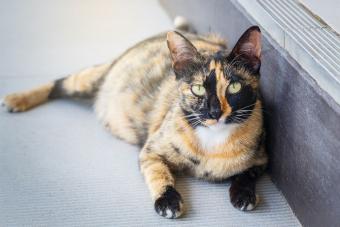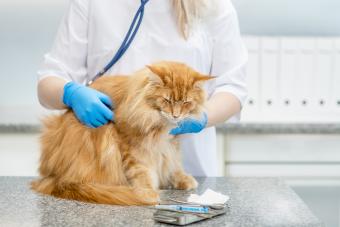
It might seem strange to picture a cat with extra toes, but these cats are actually quite common. Owning a polydactyl cat and learning more about their unusual mutation is fascinating.
What Is a Polydactyl Cat?
Polydactyl comes from a combination of two Greek words. "Poly" means many and "daktylos" means digits such as one's fingers or toes.
- A "regular" cat will have a total of 18 toes with five each on both front paws and four each on their back paws.
- A polydactyl cat can have one or two extra toes on their paws and these most often are on the "thumb side" of a cat's paws.
- The number of extra toes isn't always consistent, so a cat could have one extra on their right front paw and two extra on their left front paw.
What Causes Polydactylism?
Polydactyly is a genetic mutation that can be found in many animal species, including humans. It is an "incomplete dominant" gene that leads to a polydactyl cat about 40 to 50% of the time when it is present in a cat's genetic makeup.

Types of Polydactylism
There are several variations of polydactyly found in cats.
- Most often a cat's front paws will have extra toes rather than his or her rear feet.
- If a cat has extra toes on their rear paws, they will always have them on their front paws as well.
- A cat can have extra dew claws instead of toes, which is known as a "thumb cat polydactyl" since the extra dew claw gives the appearance of a thumb.
- Cats can be born with a condition called a triphalangeal pollex, or "three-boned thumb" which is actually a physical deformity of the cat's forearm. These cats are called "twisty cats."
- Cats with a triphalangeal pollex should be spayed or neutered as this particular genetic mutation can lead to kittens with further physical deformities of the forearm such as feline radial hypoplasia which can be disabling.
The Record for Polydactyl Cats
According to the Guinness Book of World Records, a ginger tabby cat in Canada named Jake holds the record for most toes. Jake has seven toes on each foot for a total of 28. However another cat has since tied Jake for the record and she is appropriately named Paws. This Minnesotan cat white and tabby cat has three extra toes on each front paw and one extra on each back foot.
How Common are Polydactyl Cats?
Polydactyl cats are fairly common although they tend to be found more in the western parts of England and the east coast of the U.S. and Canada. The reason for this geographic distribution is that polydactyl cats were in high demand on ships that crossed the Atlantic. In fact one nickname for polydactyls is "Boston cats" or "Boston thumb cats" because they are so prevalent in the city which corresponds to Boston's history as an active port city.
Are Polydactyl Cats a Breed?
Polydactyl cats are not a breed of cat although there is a new breed called the American Polydactyl which is not recognized by the major cat breeder associations. The mutation also tends to have a higher incidence in the Maine Coon breed with a one time about 40% of these cats having polydactyly. In fact, there is a subset of Maine Coons called Maine Coon Polydactyls that some breeders consider a separate breed although they are not recognized officially as such.

Nicknames for Polydactyl Cats
Polydactyl cats are known by various nicknames including:
- "Boston thumb cats" or "Boston cats", due to the high number of them in the city.
- "Mitten cats", "thumb cats" or "thumb cat polydactyls" which is related to polydactyly where the extra digit is a dewclaw.
- "Ship cats" because sailors regarded them as lucky and kept them on their sea journeys.
- Sailors were also known to call them "gypsy cats" because they believed they brought good fortune.
- "Hemingway cats" due to writer Ernest Hemingway's love for polydactyl cats.
- "Twisty cats" which is related to the physical condition feline radial hypoplasia.
- "Big foot cats' because all those toes make a cat's feet look larger than normal.
- "Cardi-cats" because there is a high population of them in the Cardigan area of England.
- "Boxing cats" since their big feet look like boxing gloves.
History of Polydactyl Cats
Polydactyl cats first became popular in the 1800s as ship cats where they were prized for their ability to hunt mice. It was thought that polydactyl cats brought a ship luck, and they had a "leg up" over non-polydactyl cats because their bigger paws gave them better balance on a rocking ship. The cats soon spread to port cities on the Eastern coast of the U.S. and Canada and the incidence of polydactyly among cats in these areas grew. They were also thought to be brought specifically to the Boston area not only by ship crews but by the Puritans who settled there as well.
Hemingway's Cats
A ship captain friend gave famed writer Ernest Hemingway a polydactyl cat who he named Snow White. Hemingway adored this cat and eventually added more polydactyl cats to his home in on an island in Key West. You can still visit his estate and museum today where about 40 to 50 cats roam the property. About half of these cats are polydactyls and most, if not all, are the descendents of Snow White.
Other Famous Polydactyl Cats
Hemingway wasn't the only Polydactyl cat lover. President Theodore Roosevelt had not only one of the first presidents to keep a cat at the White House, but his cat Slippers was also a polydactyl. In fact Roosevelt loved his cat so much he allowed him to attend state dinners to the bemusement of many important guests.
Care of Polydactyl Cats
Thankfully if you have a polydactyl cat, other than making sure your cat's nails are regularly trimmed, you have no serious health issues to worry about.
- Some polydactyl cats may be at a higher risk of ingrown nails and thus regular grooming and maintenance is important.
- Embedded extra dew claws can be painful for the cat and may need to be surgically removed.
- Depending on how their extra toes are structured, they might be at a higher risk of getting their nails snagged on a carpet or fabric, but this can be managed with regular, diligent nail trimming.
- You may also find newborn polydactyl cats where an extra toe can become fused with the nail bed of the toe next to it which may require a veterinarian to remove a digit surgically.
Feline Radial Hypoplasia
Cats with this disorder are polydactyls who also have deformed forelegs. They can be either too short or twisted or both. Cats with this condition are often called "twisty cats" and the degree of the deformity can be mild to severely debilitating. Though this painful condition is rare, it is a reason why breeder associations encourage the spaying and neutering of polydactyl cats in order to stop the gene from spreading throughout a breed's gene pool.
Finding a Polydactyl Cats
If you have your heart set on bringing home a cat with extra toes, contact your local shelter to see if they have one available. This physical quirk is not so rare that you may find a new feline friend with "big feet" sooner than you think, especially if you live in the eastern half of the U.S. and Canada.







